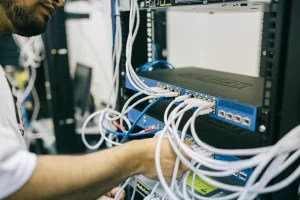This rapid expansion is reshaping the digital landscape, positioning the U.S. at the forefront of the AI revolution.
Unprecedented Growth in Data Center Infrastructure
In 2024, the U.S. data center construction market witnessed a remarkable 90% growth compared to the previous year, with investments reaching approximately $31.5 billion. This surge is primarily attributed to the increasing need for robust infrastructure to support AI workloads, including large language models and high-performance computing tasks.
Key Players and Major Projects
Leading technology firms are heavily investing in AI-focused data centers. Notably, Oracle, in collaboration with OpenAI and SoftBank, is spearheading the $100 billion “Stargate” project in Texas. This initiative aims to establish up to 20 AI data centers nationwide, with potential expansion to $500 billion over the next five years.
Similarly, Microsoft is developing a $1 billion data center campus in Mount Pleasant, Wisconsin, scheduled for completion by the end of 2025. This facility is part of Microsoft’s broader strategy to enhance its AI capabilities and cloud services.
Regional Developments and Strategic Locations
Northern Virginia continues to be a hub for data center development, hosting numerous hyperscale facilities from providers like Amazon Web Services (AWS), Microsoft, and Google. The region’s strategic location and robust infrastructure make it an attractive destination for AI data center investments.
The American Midwest is also emerging as a cost-effective alternative for data center construction. States like Wisconsin and Texas offer competitive energy prices and favorable regulatory environments, attracting both hyperscale and colocation operators.

Challenges and Considerations
Despite the rapid expansion, the data center industry faces several challenges. Power infrastructure bottlenecks are a significant concern, as the demand for electricity to support AI workloads increases. Extended timelines required to build transmission lines and secure energy resources are impacting development schedules.
Additionally, environmental considerations are prompting companies to adopt sustainable practices. For instance, Microsoft has utilized cross-laminated timber in its Northern Virginia data centers to reduce the embodied carbon footprint by up to 35% compared to steel and 65% compared to concrete.
Looking Ahead
As construction progresses, the U.S. data center infrastructure stands as a testament to the transformative power of strategic investment and international collaboration. Upon completion, it will not only meet the growing demand for AI in various industries but also pave the way for future innovations in manufacturing and sustainability.
In conclusion, the U.S. data center construction boom signifies a pivotal shift towards AI-driven infrastructure. As companies continue to invest in advanced facilities, the nation’s capacity to support AI advancements will be significantly enhanced. However, addressing power infrastructure challenges and prioritizing sustainability will be crucial to ensuring the long-term viability of these developments.
Sources: Insight Analytics Review


